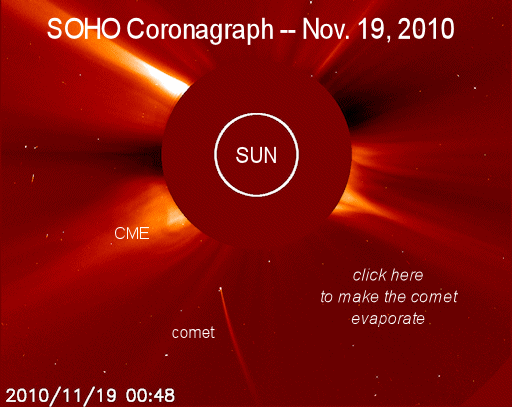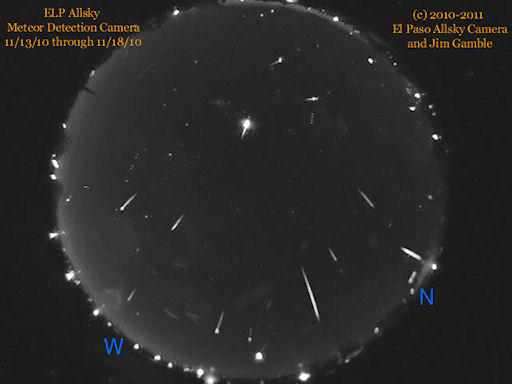AURORA ALERTS: Did you miss the Northern Lights? Next time get a wake-up call from Space Weather PHONE | | |
COMET SNOWSTORM ENGULFS HARTLEY 2: At a press conference today at NASA headquarters, researchers released beautiful new images of an unprecedented snowstorm raging around Comet Hartley 2. Get the full story from Science@NASA.
EVAPORATING COMET: A bright comet just discovered on Nov. 17th by Polish comet hunter Michal Kusiak is about to disappear forever. The problem is, it is diving toward the sun. Click on the image to view a movie of the death plunge:

Play it again and note how the head of the comet is shrinking and dimming. The icy visitor from the outer solar system is evaporating before our very eyes.
On Nov. 14th, another comet followed the same path and met the same fate. It's no coincidence. Both are fragments of a giant parent comet that broke apart about 2000 years ago. Astronomers call them "Kruetz sungrazers" after the 19th century German researcher, Heinrich Kreutz, who studied them in detail. According to some estimates, several Kruetz comets pass by the sun and disintegrate every day. Most are too small to see, but occasionally a large fragment (or two) attracts attention.
THE PASSING OF BRIAN MARSDEN: On Nov. 18th, astronomers around the world were saddened to learn that Brian Marsden died. Best known as the long-time director of the Minor Planet Center, Marsden was for decades a key figure in attending to the discovery of new comets and asteroids. He was particularly fascinated by the family of Kreutz comets, and made important contributions to the understanding of their dynamics and history. Today's bright disintegration of a Kreutz sungrazer is a fitting send-off for this eminent astronomer. [Sky & Telescope: Brian G. Marsden (1937-2010)]
LEONID RECAP: Earth is exiting a thicket of debris from Comet Tempel-Tuttle, source of the annual Leonid meteor shower. According to international counts, the shower crested on Nov. 17th and 18th with a peak rate of 20 meteors per hour. Compared to, say, the Leonid storms of a decade ago, it was not an impressive display--that is, unless you added it up for five nights in a row:

"These are all the Leonid fireballs I recorded from Nov. 13th to Nov. 18th," says Jim Gamble, who operates an all-sky camera in El Paso, Texas. "In total, there were 16 Leonids of magnitude -3 or brighter." Considering that Earth missed the densest part of the Leonid debris stream in 2010, more than a dozen fireballs is a good haul.
A bigger display is coming: In early December, Earth will enter a cloud of debris from extinct comet Phaethon, setting off the annual Geminid meteor shower. On peak night, Dec. 14th, forecasters expect as many as 100 meteors per hour, five times greater than the waning Leonids. Stay tuned!
more images: from Yuichi Takasaka of Gingolx (Kincolith), British Columbia, Canada; from Thomas Kerns of Homer, Alaska; from Yaron Eini of Jerusalem, Israel;
November 2010 Aurora Gallery
[previous Novembers: 2009, 2008, 2007, 2006, 2004, 2003, 2002, 2001, 2000]
Potentially Hazardous Asteroids (
PHAs) are space rocks larger than approximately 100m that can come closer to Earth than 0.05 AU. None of the known PHAs is on a collision course with our planet, although astronomers are finding
new ones all the time.
On November 19, 2010 there were 1164 potentially hazardous asteroids.
Notes: LD means "Lunar Distance." 1 LD = 384,401 km, the distance between Earth and the Moon. 1 LD also equals 0.00256 AU. MAG is the visual magnitude of the asteroid on the date of closest approach. | | The official U.S. government space weather bureau |
| | The first place to look for information about sundogs, pillars, rainbows and related phenomena. |
| | Researchers call it a "Hubble for the sun." SDO is the most advanced solar observatory ever. |
| | 3D views of the sun from NASA's Solar and Terrestrial Relations Observatory |
| | Realtime and archival images of the Sun from SOHO. |
| | from the NOAA Space Environment Center |
| | the underlying science of space weather |

